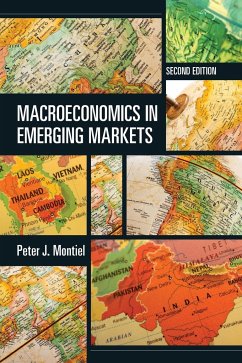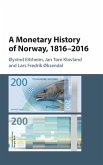Peter J. Montiel
Macroeconomics in Emerging Markets
Peter J. Montiel
Macroeconomics in Emerging Markets
- Gebundenes Buch
- Merkliste
- Auf die Merkliste
- Bewerten Bewerten
- Teilen
- Produkt teilen
- Produkterinnerung
- Produkterinnerung
This second edition textbook shows how macroeconomic models for industrial countries may be applied to emerging and developing economies.
Andere Kunden interessierten sich auch für
![Macroeconomics in Emerging Markets Macroeconomics in Emerging Markets]() Peter J. MontielMacroeconomics in Emerging Markets94,99 €
Peter J. MontielMacroeconomics in Emerging Markets94,99 €![Reconstructing Macroeconomics Reconstructing Macroeconomics]() Masanao AokiReconstructing Macroeconomics35,99 €
Masanao AokiReconstructing Macroeconomics35,99 €![The New Economics of Inequality and Redistribution The New Economics of Inequality and Redistribution]() Samuel BowlesThe New Economics of Inequality and Redistribution23,99 €
Samuel BowlesThe New Economics of Inequality and Redistribution23,99 €![Edward A. Tenenbaum and the Deutschmark Edward A. Tenenbaum and the Deutschmark]() Carl-Ludwig HoltfrerichEdward A. Tenenbaum and the Deutschmark125,99 €
Carl-Ludwig HoltfrerichEdward A. Tenenbaum and the Deutschmark125,99 €![Agriculture and the New Trade Agenda Agriculture and the New Trade Agenda]() Merlinda D. Ingco / L. Alan Winters (eds.)Agriculture and the New Trade Agenda34,99 €
Merlinda D. Ingco / L. Alan Winters (eds.)Agriculture and the New Trade Agenda34,99 €![Dynamic Modeling and Applications for Global Economic Analysis Dynamic Modeling and Applications for Global Economic Analysis]() Dynamic Modeling and Applications for Global Economic Analysis122,99 €
Dynamic Modeling and Applications for Global Economic Analysis122,99 €![A Monetary History of Norway, 1816-2016 A Monetary History of Norway, 1816-2016]() Øyvind EitrheimA Monetary History of Norway, 1816-2016200,99 €
Øyvind EitrheimA Monetary History of Norway, 1816-2016200,99 €-
-
-
This second edition textbook shows how macroeconomic models for industrial countries may be applied to emerging and developing economies.
Hinweis: Dieser Artikel kann nur an eine deutsche Lieferadresse ausgeliefert werden.
Hinweis: Dieser Artikel kann nur an eine deutsche Lieferadresse ausgeliefert werden.
Produktdetails
- Produktdetails
- Verlag: Cambridge University Press
- Seitenzahl: 778
- Erscheinungstermin: 16. Juni 2011
- Englisch
- Abmessung: 260mm x 183mm x 46mm
- Gewicht: 1631g
- ISBN-13: 9780521514729
- ISBN-10: 052151472X
- Artikelnr.: 35482088
- Herstellerkennzeichnung
- Libri GmbH
- Europaallee 1
- 36244 Bad Hersfeld
- gpsr@libri.de
- Verlag: Cambridge University Press
- Seitenzahl: 778
- Erscheinungstermin: 16. Juni 2011
- Englisch
- Abmessung: 260mm x 183mm x 46mm
- Gewicht: 1631g
- ISBN-13: 9780521514729
- ISBN-10: 052151472X
- Artikelnr.: 35482088
- Herstellerkennzeichnung
- Libri GmbH
- Europaallee 1
- 36244 Bad Hersfeld
- gpsr@libri.de
Peter J. Montiel is Farleigh S. Dickinson, Jr, '41 Professor of Economics at Williams College, Massachusetts. He formerly taught at Florida International University, Amherst College and Oberlin College. Professor Montiel held positions as Senior Policy Advisor at the International Monetary Fund and as Chief of the Macroeconomics and Growth Division of the Policy Research Department of the World Bank. He has served on the editorial board of several professional journals and is a past Associate Editor of World Development. He is the author of nine books, including most notably the three editions of Development Economics (with Pierre-Richard Agenor) and a large number of articles in professional journals. Professor Montiel has been a Visiting Scholar at the IMF, the World Bank, the Inter-American Development Bank, the University of Manchester, the University of Helsinki and the Monetary Authority of Singapore.
Preface
Part I. The Macroeconomic Framework: 1. Introduction and overview
2. Concepts and definitions: the macroeconomic accounts
3. Short-run macroeconomics and long-run growth
Part II. A Benchmark Macroeconomic Model: 4. The aggregate production function, the labor market, and aggregate supply
5. Aggregate demand and goods market equilibrium
6. Financial markets
7. Short-run macroeconomic equilibrium
8. Medium-run macroeconomic equilibrium
Part III. Public Finance and Macroeconomic Performance: 9. The intertemporal budget constraint of the public sector
10. Sovereign risk premia
11. Fiscal institutions
12. Privatization
13. High inflation and inflation stabilization
Part IV. Monetary Institutions and Monetary Policy: 14. Monetary institutions
15. Inflation targeting
Part V. Exchange Rate Management: 16. Equilibrium real exchange rates
17. The benchmark model with floating exchange rates
18. Exchange rate regimes
19. Managing an officially-determined rate
Part VI. The Financial Sector and Macroeconomic Performance: 20. Finance, welfare, and growth
21. Financial repression
22. Financial reform
23. The benchmark model with banks
24. Coping with capital inflows
Part VII. Varieties of Emerging-Market Crises: 25. Sovereign debt crises
26. Banking crises
27. Currency crises and crisis interactions
28. Lessons from the emerging market crises of the nineties
29. Lessons from the great recession.
Part I. The Macroeconomic Framework: 1. Introduction and overview
2. Concepts and definitions: the macroeconomic accounts
3. Short-run macroeconomics and long-run growth
Part II. A Benchmark Macroeconomic Model: 4. The aggregate production function, the labor market, and aggregate supply
5. Aggregate demand and goods market equilibrium
6. Financial markets
7. Short-run macroeconomic equilibrium
8. Medium-run macroeconomic equilibrium
Part III. Public Finance and Macroeconomic Performance: 9. The intertemporal budget constraint of the public sector
10. Sovereign risk premia
11. Fiscal institutions
12. Privatization
13. High inflation and inflation stabilization
Part IV. Monetary Institutions and Monetary Policy: 14. Monetary institutions
15. Inflation targeting
Part V. Exchange Rate Management: 16. Equilibrium real exchange rates
17. The benchmark model with floating exchange rates
18. Exchange rate regimes
19. Managing an officially-determined rate
Part VI. The Financial Sector and Macroeconomic Performance: 20. Finance, welfare, and growth
21. Financial repression
22. Financial reform
23. The benchmark model with banks
24. Coping with capital inflows
Part VII. Varieties of Emerging-Market Crises: 25. Sovereign debt crises
26. Banking crises
27. Currency crises and crisis interactions
28. Lessons from the emerging market crises of the nineties
29. Lessons from the great recession.
Preface
Part I. The Macroeconomic Framework: 1. Introduction and overview
2. Concepts and definitions: the macroeconomic accounts
3. Short-run macroeconomics and long-run growth
Part II. A Benchmark Macroeconomic Model: 4. The aggregate production function, the labor market, and aggregate supply
5. Aggregate demand and goods market equilibrium
6. Financial markets
7. Short-run macroeconomic equilibrium
8. Medium-run macroeconomic equilibrium
Part III. Public Finance and Macroeconomic Performance: 9. The intertemporal budget constraint of the public sector
10. Sovereign risk premia
11. Fiscal institutions
12. Privatization
13. High inflation and inflation stabilization
Part IV. Monetary Institutions and Monetary Policy: 14. Monetary institutions
15. Inflation targeting
Part V. Exchange Rate Management: 16. Equilibrium real exchange rates
17. The benchmark model with floating exchange rates
18. Exchange rate regimes
19. Managing an officially-determined rate
Part VI. The Financial Sector and Macroeconomic Performance: 20. Finance, welfare, and growth
21. Financial repression
22. Financial reform
23. The benchmark model with banks
24. Coping with capital inflows
Part VII. Varieties of Emerging-Market Crises: 25. Sovereign debt crises
26. Banking crises
27. Currency crises and crisis interactions
28. Lessons from the emerging market crises of the nineties
29. Lessons from the great recession.
Part I. The Macroeconomic Framework: 1. Introduction and overview
2. Concepts and definitions: the macroeconomic accounts
3. Short-run macroeconomics and long-run growth
Part II. A Benchmark Macroeconomic Model: 4. The aggregate production function, the labor market, and aggregate supply
5. Aggregate demand and goods market equilibrium
6. Financial markets
7. Short-run macroeconomic equilibrium
8. Medium-run macroeconomic equilibrium
Part III. Public Finance and Macroeconomic Performance: 9. The intertemporal budget constraint of the public sector
10. Sovereign risk premia
11. Fiscal institutions
12. Privatization
13. High inflation and inflation stabilization
Part IV. Monetary Institutions and Monetary Policy: 14. Monetary institutions
15. Inflation targeting
Part V. Exchange Rate Management: 16. Equilibrium real exchange rates
17. The benchmark model with floating exchange rates
18. Exchange rate regimes
19. Managing an officially-determined rate
Part VI. The Financial Sector and Macroeconomic Performance: 20. Finance, welfare, and growth
21. Financial repression
22. Financial reform
23. The benchmark model with banks
24. Coping with capital inflows
Part VII. Varieties of Emerging-Market Crises: 25. Sovereign debt crises
26. Banking crises
27. Currency crises and crisis interactions
28. Lessons from the emerging market crises of the nineties
29. Lessons from the great recession.








